How did the Neanderthals make a spear? That might seem like a fairly basic question, but it's surprisingly tough to answer. The fragments of tools left behind by Homo neanderthalensis isn't enough to tell you. You have to get your hands dirty.
Fortunately, I recently had the opportunity to do just that. Or rather, watch someone else get their hands dirty. James Dilley of Ancient Craft swung by Liverpool to make a Neanderthal style spear here. It was an eye-opening experience that certainly but a lot of theory and conjecture in a real world context.
I was live-tweeting the whole thing (in case you didn't have enough motivation to follow me already). But for posterity, here's a bit more permanent (and detailed) explanation of what happened.
Muddling over the Mousterian
The backbone of Neanderthal technology for most of their existence was the Mousterian toolkit. One of the defining characteristics of this toolkit is the way tools were made: via prepared cores. A ridge would be created on a rock that, when hit, would come off into a sharp flake that could be turned into a tool. Thus by creating a ridge of the size and shape you wanted beforehand the actual "tool making" process is brief.
This predictability (and speed) are the main advantages the Mousterian has. The other big factor is that removing one flake will create more ridges, instantly making it possible to start removing more tools. James' first removal - whilst not exactly where he predicted - was pretty good. But he was able to make a few more "for safety" with ease; after that initial set-up was complete.
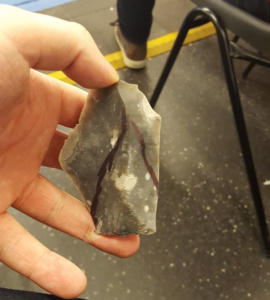
In fact, one of these spares was turned notched, turning it into a little saw. This was then used to cut a slit in the top of the spear shaft, where the final point would be placed. One rock produced two totally different tools with very little effort.
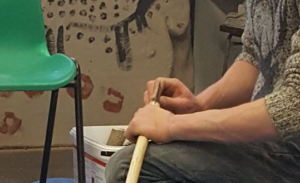
Within about half an hour he had a stick and a point. The next step was to combine them.
Turning a rock into a spear
The glue to combine the two was birch tar, made by boiling up birch bark (as the name suggests). It's a fascinating material. After the initial manufacture it "sets" into a rock hard substance. It can be turned sticky again with heat, but in the meantime this makes it really easy to transport. James brings it around in seashells, for that authentic palaeolithic touch.
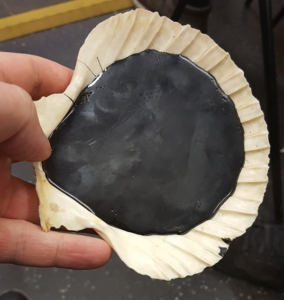
It's a good thing that it is easy to transport because it's ruddy hard to come by. When "boiling" the birch bark to make it the tar itself evaporates. As such, if there's any hole in your 'kiln' all of that precious work will just disappear. It has to be air tight. Given such simple mistakes can lead to the loss of the whole batch, it can take an awfully long time to produce a useable amount. It also means nobody has quite figured out how to make it in an authentic Neanderthal way. Most people - including James - boil the birch in sealed tin cans. Hardly prehistoric.
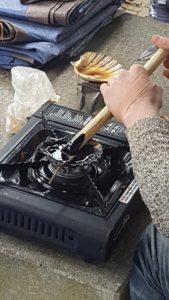
Once heated, the birch becomes a fairly standard glue that can be used to attach the point to the spear shaft. The final step is wrapping the joint. This helps both reinforce the join, and keep it stable whilst the birch cools again.
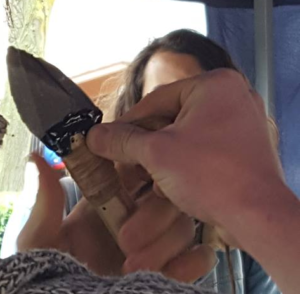
The "string" was actually thin pieces of bark, removed in spring where it just peels right off the tree in long stringy layers. Interestingly, once removed from the tree it doesn't rot for an awfully long time. Perhaps the Neanderthals had a harvest which they could keep using all year. Regardless of how they did it (and whether it involved tin cans) that was all that was really needed. We finally had a Neanderthal spear.

